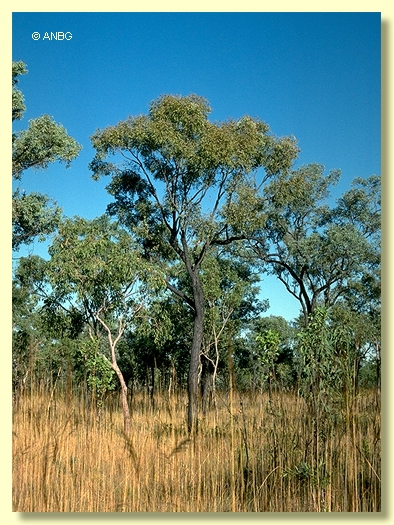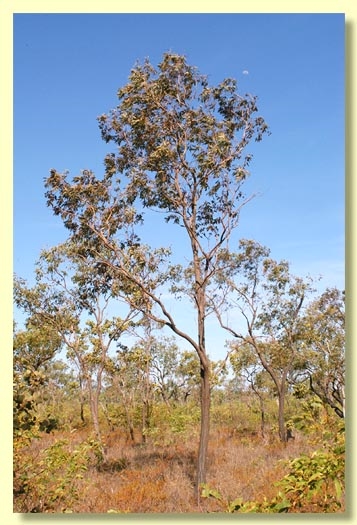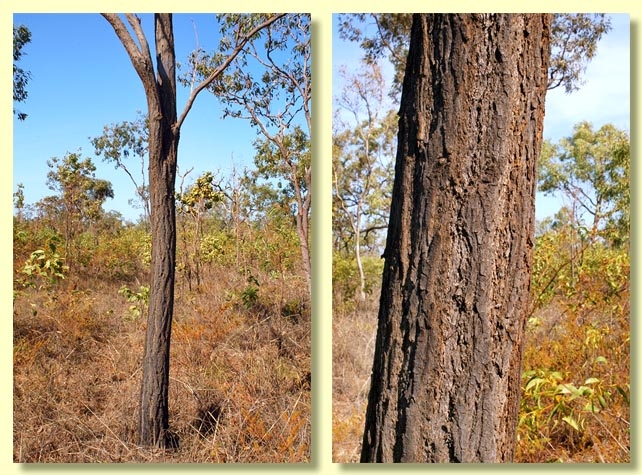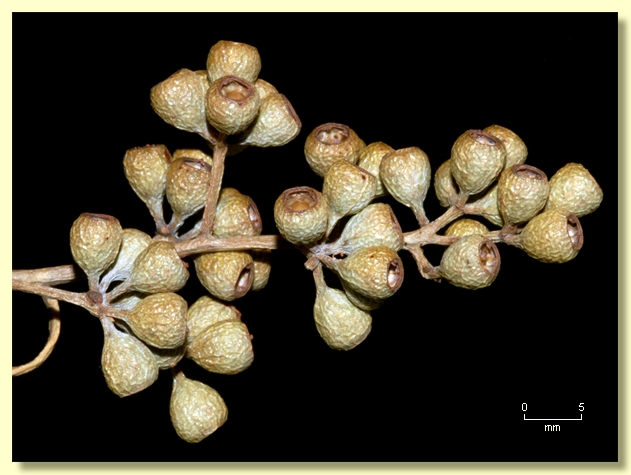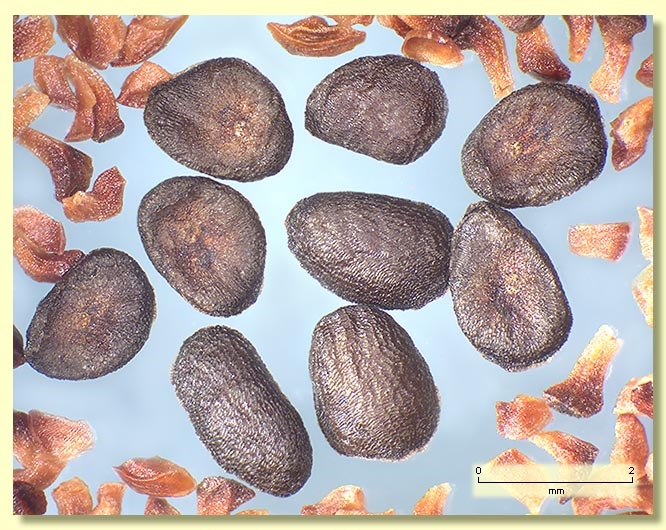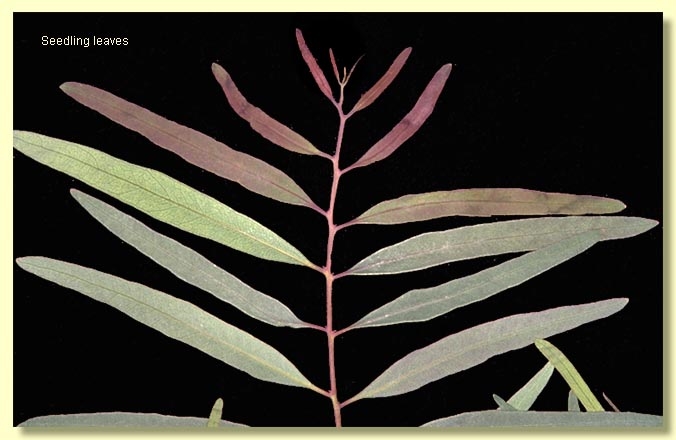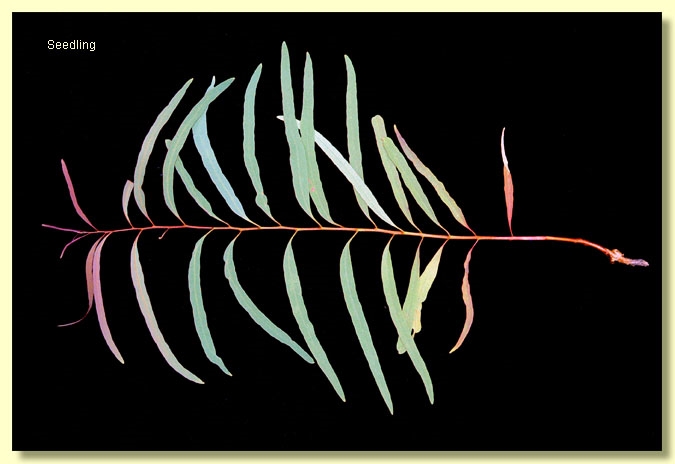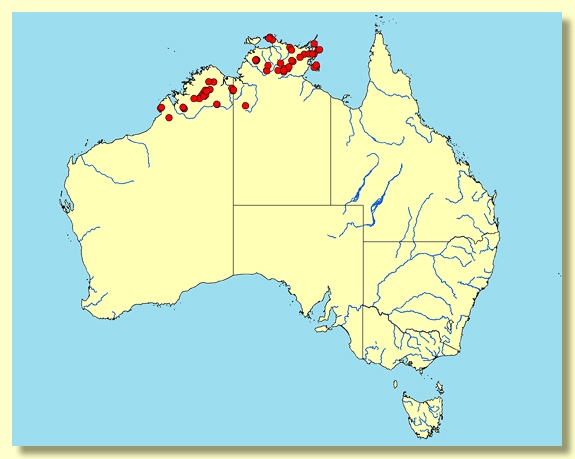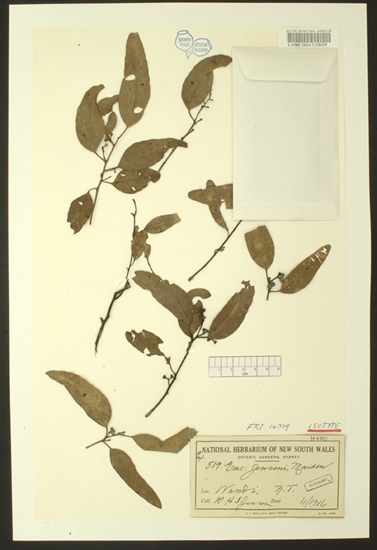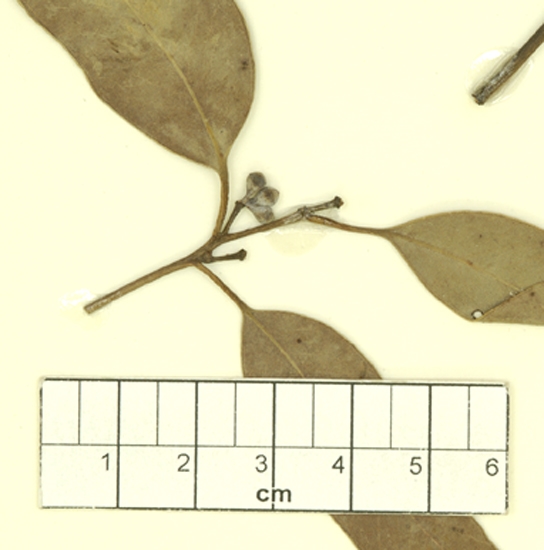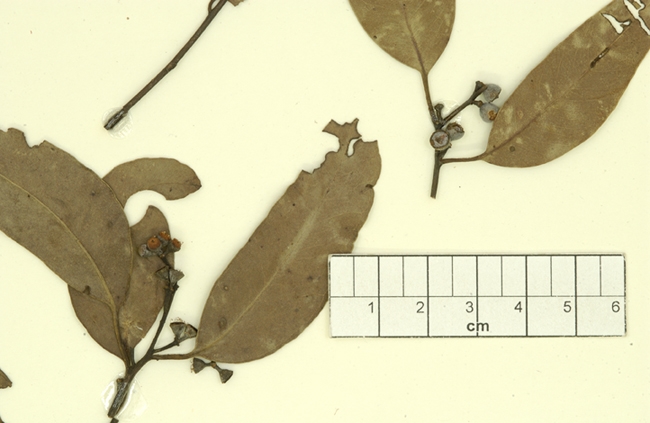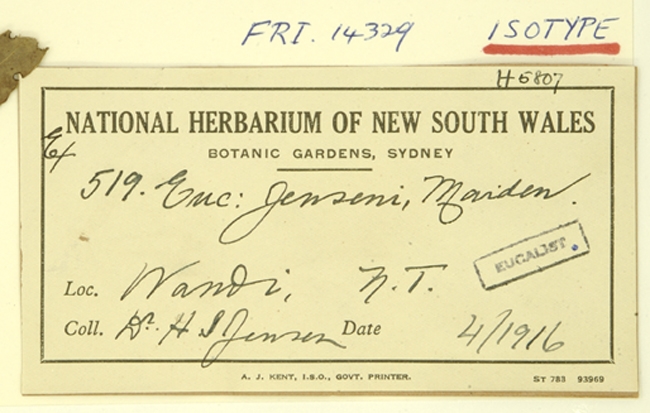Euclid - Online edition
Eucalyptus jensenii
Eucalyptus | Symphyomyrtus | Adnataria | Apicales | Siderophloiae | Subglaucae
Tree to 10 m tall. Forming a lignotuber.
Bark rough, coarse, hard, black, furrowed, i.e. typical ironbark, extending to branches ca 3 cm diameter.
Branchlets lack oil glands in the pith; glaucous or non-glaucous.
Juvenile growth (coppice or field seedlings to 50 cm): stems rounded in cross-section; juvenile leaves always petiolate, opposite at first then becoming alternate, ovate to elliptical, 3.8–6.5 cm long, (1.6)2–3 cm wide, base rounded to tapering, dull, grey-green.
Adult leaves alternate, petioles 0.3–2 cm long; blade ovate to lanceolate or elliptical, 4.3–11.5 cm long, 0.7–3(4) cm wide, base tapering, margin entire, apex pointed or rounded, concolorous, dull, green to grey-green or slightly glaucous, side-veins acute or greater than 45° to midrib, reticulation very dense, intramarginal vein present, oil glands scattered intersectional or apparently absent.
Inflorescence terminal compound and a few single axillary umbels also, peduncles 0.2–0.8 cm long, buds 7 per umbel, pedicels 0.1–0.3 cm long. Mature buds pyriform to obovoid, 0.3–0.4 cm long, 0.2–0.3 cm wide, glaucous or not glaucous, scar present (outer operculum shed early), operculum conical, stamens irregularly flexed, all fertile, anthers adnate, basifixed, cuboid, dehiscing by lateral slits, style straight and long, stigma blunt, locules 3, the placentae each with 4 vertical ovule rows. Flowers creamy white.
Fruit pedicellate or rarely sessile (pedicels to 0-0.3 cm long), barrel-shaped to truncate-globose or hemispherical or tending to obconical, 0.3–0.5 cm long, 0.3–0.5 cm wide, glaucous or non-glaucous, disc descending vertically, valves 3, near rim level but rarely visibly exserted.
Seeds brown to blackish, 1.3–3 mm long, flattened-ovoid, dorsal surface smooth to shallowly reticulate, hilum ventral.
Cultivated seedlings (measured at ca node 10): cotyledons small, reniform; stems square to ± rounded in cross-section, non-glaucous or rarely slightly glaucous; leaves always petiolate (petioles 0.2–0.7 cm), opposite for ca 8 to 15 nodes then becoming alternate, rarely still opposite at node 20, linear to narrowly lanceolate, 3.5–10 cm long, 0.4–1.5 cm wide, base tapering, apex ± pointed, dull, green to grey-green, not glaucous, concolorous or slightly discolorous.
Flowering has been recorded in March and April.
An ironbark tree found in the Edgar Range, Dampier Peninsula and common in the central and northern Kimberley region of Western Australia. It also occurs in the Top End of the Northern Territory where more sporadically distributed including in the Keep River area, Adelaide River, Sleisbeck, Mainorou, Cobourg Peninsula, English Company Islands and Groote Eylandt in the western part of the Gulf of Carpentaria. Eucalyptus jensenii grows in savannah woodland and monsoon thicket and prefers sandy or gravelly soils on gentle to moderate slopes and elevated areas. Within its natural range E. jensenii is the only "ironbark" species and is easily distinguished from all associates by its blackish furrowed rough bark over trunk and branches, and crown of dull grey-green small leaves.
Eucalyptus jensenii belongs in Eucalyptus subgenus Symphyomyrtus section Adnataria because the buds have two opercula, ovules are in four rows, seeds flattened-ovoid, cotyledons reniform, and anthers rigid on the staminal filaments. Within section Adnataria, E. jensenii is part of series Siderophloiae subseries Subglaucae, further distinguished by being trees with ironbark, and having predominantly terminal inflorescences, buds shedding the outer operculum early in development, stamens irregularly flexed in bud and all fertile, and juvenile leaves petiolate and not persisting into the mature crown. All other ironbark species in this group belong in eastern Australia from the temperate Sydney region north to tropical Torres Strait, including the widespread E. crebra and about 20 other taxa.
MORE ABOUT IRONBARKS
Eucalyptus jensenii : after Dr. Harald Ingemann Jensen (1879–1966). Harald Jensen was born in Jutland, Denmark. It is not known when he came to Australia but he completed his undergraduate degree at Sydney University in 1903. He was chief Government geologist of the Northern Territory from 1912–1916 and then temporary Government geologist in Queensland from 1917–1922 after which he spent most of his career as a consulting geologist. He had a keen interest in plants and collected the type specimen of this species in 1916. He wrote many scientific papers and reports. He also had an interest in socialism and wrote in 1908, The Rising Tide, An Exposition of Australian Socialism (published in the Australian Worker).

